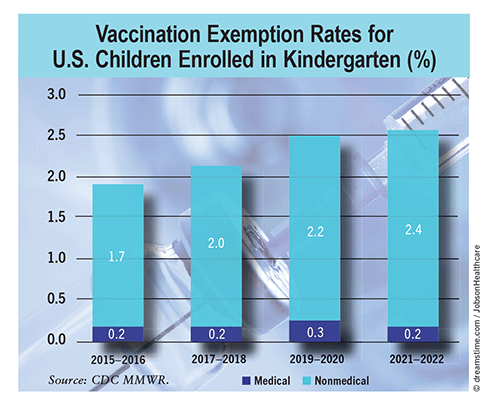US Pharm. 2023;48(8):14.
According to the United Nations International Children’s Emergency Fund (UNICEF) and the World Health Organization, worldwide vaccination rates remained stable until the COVID-19 pandemic. Subsequent disruptions in healthcare systems and services led to a lack of completed routine vaccinations among approximately 25 million children—nearly 6 million more than before the pandemic in 2019, and the highest number since 2009. Overall global vaccination coverage dropped from 86% to 81% between 2019 and 2021, resulting in at least 200,000 young lives lost.

Coverage Rates: In an effort to reduce rates of infectious diseases and the burden of potential vaccine-preventable disease outbreaks, all 50 U.S. states and the District of Columbia require certain vaccinations (e.g., measles, rubella, diphtheria, tetanus, acellular pertussis, and poliovirus) for children attending public schools. These regulations contribute to vaccination-coverage rates that often exceed those in other countries; however, rates for all state-required vaccinations among children entering kindergarten declined from almost 95% during the 2017–2018, 2018–2019, and 2019–2020 school years to 94% and 93% during the 2020–2021 and 2021–2022 school years, respectively. The CDC estimates that every 1% decrease represents a minimum of 35,000 children without adequate documentation of state-required vaccinations.
Exemption Rates: U.S. vaccination exemptions vary from state to state and include medical as well as nonmedical reasons. All 50 states and the District of Columbia allow medical exemptions for required public-school vaccinations, 44 states and the District of Columbia permit religious exemptions, and 15 states grant philosophical exemptions. Between the 2015–2016 and 2021–2022 school years, total exemptions increased from 1.9% to 2.6%. The percentage of children entering kindergarten who lacked exemptions and were not up-to-date with their vaccinations increased from 2.8% in 2018–2019 to 3.9% in 2021–2022.
Hesitancy and Confidence: The gradual increases in exemptions and number of children entering kindergarten without exemptions or completed vaccination requirements may be due to factors such as fewer well-child visits and widespread vaccine misinformation during the COVID-19 pandemic. Also, parental hesitancy over routine childhood vaccinations has increased, whereas vaccine confidence has decreased. Studies reveal that the most common concerns among parents are vaccine safety, perceptions of disease susceptibility and severity, and distrust of public-health authorities. In a 2023 Pew Research Center survey, 70% of Americans expressed support for vaccinating healthy children entering public schools, compared with 82% who supported these vaccination requirements in 2019 and 2016. Additionally, 28% of parents stated that they should be able to decide whether or not to vaccinate their children, an increase of 12% from 2019. The CDC has launched the Vaccinate with Confidence strategic framework, available at www.cdc.gov/vaccines/, to address these trends and avert future outbreaks of vaccine-preventable diseases in the U.S.
The content contained in this article is for informational purposes only. The content is not intended to be a substitute for professional advice. Reliance on any information provided in this article is solely at your own risk.
To comment on this article, contact rdavidson@uspharmacist.com.





